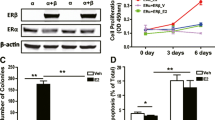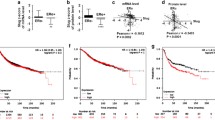Abstract
p53 is a tumor suppressor protein that regulates estrogen receptor 1 (ESR1) expression. To investigate the mechanism of ESR1 gene regulation by p53, chromatin immunoprecipitation was applied to assess the binding of p53, DNMT1, HDAC1 and MeCP2 to both silenced ESR1 promoter in MDA-MB-468 cells and active ESR1 promoter in MCF-7 breast cancer cells. The results of chromatin immunoprecipitation experiments showed that p53 protein binds to both unmethylated CpG island of the ESR1 promoter in the ER-positive MCF-7 and the hypermethylated ESR1 promoter in the ER-negative MDA-MB-468 cells. However, repression complex including DNMT1, HDAC1 and MeCP2 is only associated with silenced ESR1 in ER-negative MDA-MB-468 human breast cancer cells. In addition, ectopically expressed wild type p53 failed to reactivate the ESR1 gene in these cells. These results suggest that specific p53 mutations may contribute to loss of estrogen receptor α expression in breast tumors and also support the hypothesis that mutant p53 is likely to impact DNA methylation.



Similar content being viewed by others
Abbreviations
- ESR1 :
-
estrogen receptor 1
- DNMT1:
-
DNA methyltransferase 1
- HDAC1:
-
histone deacetylase 1
- MeCP2:
-
methyl-CpG-binding protein
- ER:
-
estrogen receptor
- ChIP:
-
Chromatin immunoprecipitation
- RT-PCR:
-
reverse transcription-PCR
- siRNA:
-
small interfering RNA
References
Millau JF, Bastien N, Drouin R (2009) p53 transcriptional activities: a general overview and some thoughts. Mutat Res 681:118–133
Olsson A, Manzl C, Strasser A et al (2007) How important are post-translational modifications in p53 for selectivity in target-gene transcription and tumour suppression? Cell Death Differ 14:1561–1575
Harms K, Nozell S, Chen X (2004) The common and distinct target genes of the p53 family transcription factors. Cell Mol Life Sci 61:822–842
Helton ES, Chen X (2007) p53 modulation of the DNA damage response. J Cell Biochem 100:883–896
Murphy M, Ahn J, Walker KK et al (1999) Transcriptional repression by wild-type p53 utilizes histone deacetylases, mediated by interaction with mSin3a. Genes Dev 13:2490–2501
Seto E, Usheva A, Zambetti GP et al (1992) Wild-type p53 binds to the TATA-binding protein and represses transcription. Proc Natl Acad Sci U S A 89:12028–12032
Amaral JD, Xavier JM, Steer CJ et al (2010) The role of p53 in apoptosis. Discov Med 9:145–152
Olivier M, Eeles R, Hollstein M et al (2002) The IARC TP53 database: new online mutation analysis and recommendations to users. Hum Mutat 19:607–614
Angeloni SV, Martin MB, Garcia-Morales P et al (2004) Regulation of estrogen receptor-alpha expression by the tumor suppressor gene p53 in MCF-7 cells. J Endocrinol 180:497–504
Luczak MW, Jagodzinski PP (2006) The role of DNA methylation in cancer development. Folia Histochem Cytobiol 44:143–154
Miremadi A, Oestergaard MZ, Pharoah PD, et al. (2007) Cancer genetics of epigenetic genes. Hum Mol Genet 16 Spec No 1:R28-R49.
Parrella P, Poeta ML, Gallo AP et al (2004) Nonrandom distribution of aberrant promoter methylation of cancer-related genes in sporadic breast tumors. Clin Cancer Res 10:5349–5354
Costello JF, Fruhwald MC, Smiraglia DJ et al (2000) Aberrant CpG-island methylation has non-random and tumour-type-specific patterns. Nat Genet 24:132–138
Sharma D, Blum J, Yang X et al (2005) Release of methyl CpG binding proteins and histone deacetylase 1 from the Estrogen receptor alpha (ER) promoter upon reactivation in ER-negative human breast cancer cells. Mol Endocrinol 19:1740–1751
Yan L, Nass SJ, Smith D et al (2003) Specific inhibition of DNMT1 by antisense oligonucleotides induces re-expression of estrogen receptor-alpha (ER) in ER-negative human breast cancer cell lines. Cancer Biol Ther 2:552–556
Yang X, Ferguson AT, Nass SJ et al (2000) Transcriptional activation of estrogen receptor alpha in human breast cancer cells by histone deacetylase inhibition. Cancer Res 60:6890–6894
Berns EM, Klijn JG, Smid M et al (1996) TP53 and MYC gene alterations independently predict poor prognosis in breast cancer patients. Genes Chromosomes Cancer 16:170–179
Giacinti L, Claudio PP, Lopez M et al (2006) Epigenetic information and estrogen receptor alpha expression in breast cancer. Oncologist 11:1–8
Suzuki M, Sunaga N, Shames DS et al (2004) RNA interference-mediated knockdown of DNA methyltransferase 1 leads to promoter demethylation and gene re-expression in human lung and breast cancer cells. Cancer Res 64:3137–3143
Lapidus RG, Nass SJ, Butash KA et al (1998) Mapping of ER gene CpG island methylation-specific polymerase chain reaction. Cancer Res 58:2515–2519
Yan L, Yang X, Davidson NE (2001) Role of DNA methylation and histone acetylation in steroid receptor expression in breast cancer. J Mammary Gland Biol Neoplasia 6:183–192
Vinyals A, Peinado MA, Gonzalez-Garrigues M et al (1999) Failure of wild-type p53 gene therapy in human cancer cells expressing a mutant p53 protein. Gene Ther 6:22–33
Yang X, Phillips DL, Ferguson AT et al (2001) Synergistic activation of functional estrogen receptor (ER)-alpha by DNA methyltransferase and histone deacetylase inhibition in human ER-alpha-negative breast cancer cells. Cancer Res 61:7025–7029
Esteller M (2002) CpG island hypermethylation and tumor suppressor genes: a booming present, a brighter future. Oncogene 21:5427–5440
Ho JS, Ma W, Mao DY et al (2005) p53-Dependent transcriptional repression of c-myc is required for G1 cell cycle arrest. Mol Cell Biol 25:7423–7431
Imbriano C, Gurtner A, Cocchiarella F et al (2005) Direct p53 transcriptional repression: in vivo analysis of CCAAT-containing G2/M promoters. Mol Cell Biol 25:3737–3751
Scoumanne A, Chen X (2006) The epithelial cell transforming sequence 2, a guanine nucleotide exchange factor for Rho GTPases, is repressed by p53 via protein methyltransferases and is required for G1-S transition. Cancer Res 66:6271–6279
Sengupta S, Shimamoto A, Koshiji M et al (2005) Tumor suppressor p53 represses transcription of RECQ4 helicase. Oncogene 24:1738–1748
Horvath MM, Wang X, Resnick MA et al (2007) Divergent evolution of human p53 binding sites: cell cycle versus apoptosis. PLoS Genet 3:e127
Wei CL, Wu Q, Vega VB et al (2006) A global map of p53 transcription-factor binding sites in the human genome. Cell 124:207–219
Koutsodontis G, Tentes I, Papakosta P et al (2001) Sp1 plays a critical role in the transcriptional activation of the human cyclin-dependent kinase inhibitor p21(WAF1/Cip1) gene by the p53 tumor suppressor protein. J Biol Chem 276:29116–29125
Akaogi K, Nakajima Y, Ito I et al (2009) KLF4 suppresses estrogen-dependent breast cancer growth by inhibiting the transcriptional activity of ERalpha. Oncogene 28:2894–2902
Shirley SH, Rundhaug JE, Tian J et al (2009) Transcriptional regulation of estrogen receptor-alpha by p53 in human breast cancer cells. Cancer Res 69:3405–3414
Esteve PO, Chin HG, Pradhan S (2005) Human maintenance DNA (cytosine-5)-methyltransferase and p53 modulate expression of p53-repressed promoters. Proc Natl Acad Sci U S A 102:1000–1005
Petitjean A, Mathe E, Kato S et al (2007) Impact of mutant p53 functional properties on TP53 mutation patterns and tumor phenotype: lessons from recent developments in the IARC TP53 database. Hum Mutat 28:622–629
Li SY, Rong M, Iacopetta B (2006) Germ-line variants in methyl-group metabolism genes and susceptibility to DNA methylation in human breast cancer. Oncol Rep 15:221–225
Oshiro MM, Watts GS, Wozniak RJ et al (2003) Mutant p53 and aberrant cytosine methylation cooperate to silence gene expression. Oncogene 22:3624–3634
Dhar G, Banerjee S, Dhar K et al (2008) Gain of oncogenic function of p53 mutants induces invasive phenotypes in human breast cancer cells by silencing CCN5/WISP-2. Cancer Res 68:4580–4587
Goh AM, Coffill CR, Lane DP (2011) The role of mutant p53 in human cancer. J Pathol 223:116–126
Bertheau P, Espie M, Turpin E et al (2008) TP53 status and response to chemotherapy in breast cancer. Pathobiology 75:132–139
Avila MA, Velasco JA, Cansado J et al (1994) Quercetin mediates the down-regulation of mutant p53 in the human breast cancer cell line MDA-MB468. Cancer Res 54:2424–2428
Acknowledgements
This work was supported by grants No: 87–4153 and 89–5176 from Shiraz University of Medical Sciences, Iran for Mr. Zahed Khatooni’s thesis and Mrs Rita Arabsolghar’s thesis, respectively.
Conflict of interest
None of authors has any conflict of interest.
Author information
Authors and Affiliations
Corresponding author
Rights and permissions
About this article
Cite this article
Rasti, M., Arabsolghar, R., Khatooni, Z. et al. p53 Binds to Estrogen Receptor 1 Promoter in Human Breast Cancer Cells. Pathol. Oncol. Res. 18, 169–175 (2012). https://doi.org/10.1007/s12253-011-9423-6
Received:
Accepted:
Published:
Issue Date:
DOI: https://doi.org/10.1007/s12253-011-9423-6




